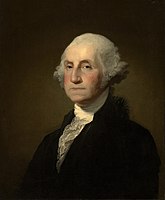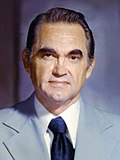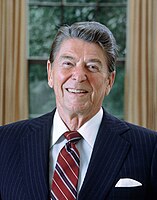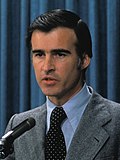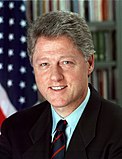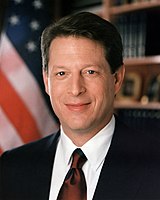User:HistorianL/sandbox
| ||||||||||||||||||||||||||||||||
69 members of the Electoral College 35 electoral votes needed to win | ||||||||||||||||||||||||||||||||
|---|---|---|---|---|---|---|---|---|---|---|---|---|---|---|---|---|---|---|---|---|---|---|---|---|---|---|---|---|---|---|---|---|
| Turnout | 18.2%[1] | |||||||||||||||||||||||||||||||
| ||||||||||||||||||||||||||||||||
| ||||||||||||||||||||||||||||||||
| No.[a] | Portrait | Name
(Birth–Death) |
Term | Party[b] | President | ||
|---|---|---|---|---|---|---|---|
| 1 | 
|
John Adams
(1735–1826) |
April 30, 1789 -
March 4, 1797 |
Pro-Administration | 1788–89 | George Washington | |
| Federalist | 1792 | ||||||
| 2 | 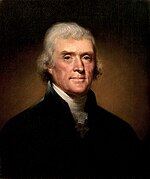
|
Thomas Jefferson
(1743–1826) |
March 4, 1797 -
March 4, 1801 |
Democratic-Republican | 1796 | John Adams | |
| 3 | 
|
Aaron Burr
(1756–1836) |
March 4, 1801 -
March 4, 1805 |
Democratic-Republican | 1800 | Thomas Jefferson | |
| 4 | 
|
George Clinton
(1739–1812) |
March 4, 1805 -
April 12, 1812 |
Democratic-Republican | 1804 | ||
| 1808 | James Madison | ||||||
| Office vacant April 12, 1812 - March 4, 1813 | |||||||
| 5 | 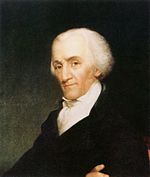
|
Elbridge Gerry
(1744–1814) |
March 4, 1813 -
November 23, 1814 |
Democratic-Republican | 1812 | James Madison | |
| - | |||||||
| Office vacant November 23, 1814 - March 4, 1817 | |||||||
| 6 | 
|
Daniel D. Tompkins
(1774–1825) [2] |
March 4, 1817
– March 4, 1825 |
Democratic-Republican | 1816 | James Monroe | |
| 1820 | |||||||
| 7 | 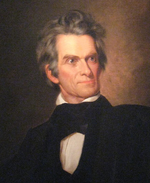
|
John C. Calhoun[c]
(1782–1850) [3] |
March 4, 1825
– December 28, 1832 |
Democratic-Republican | 1824 | John Quincy Adams | |
| Nullifier[d] | 1828 | Andrew Jackson | |||||
| Office vacant December 28, 1832 - March 4, 1833 | |||||||
| 8 | 
|
Martin Van Buren
(1782–1862) |
March 4, 1833
– March 4, 1837 |
Democratic | 1832 | Andrew Jackson | |
| 9 | Tobias Norton
(1793–1868) |
March 4, 1837
– March 4, 1841 |
Democratic-Republican | 1836 | Davy Crockett | ||
| 10 | George E. Russell
(1790–1880) |
March 4, 1841
– March 4, 1845 |
Democratic-Republican | 1840 | |||
| 11 | 
|
Theodore Frelinghuysen
(1787–1862) |
March 4, 1845
– March 4, 1849 |
Whig | 1844 | Henry Clay | |
| 12 | 
|
Millard Fillmore
(1800–1874) |
March 4, 1849
– July 9, 1850[e] |
Whig | 1848 | Zachary Taylor | |
| Office vacant July 9, 1850 - March 4, 1853 | |||||||
| 13 | 
|
William A. Graham
(1804–1875) |
March 4, 1853
– March 4, 1857 |
Whig | 1852 | Winfield Scott | |
| 14 | 
|
William L. Dayton
(1807–1864) |
March 4, 1857
– March 4, 1861 |
Republican | 1856 | John C. Frémont | |
| 15 | 
|
Hannibal Hamlin
(1809–1891) |
March 4, 1861
– March 4, 1869 |
Republican | 1860
1864 |
Abraham Lincoln | |
| 16 | 
|
Schuylar Colfax
(1807–1864) |
March 4, 1869
– March 4, 1873 |
Republican | 1868 | Ulysses S. Grant | |
| 17 | 
|
Henry Wilson
(1807–1864) |
March 4, 1873
– November 22, 1875 |
Republican | 1872 | ||
| Office vacant November 22, 1875 - March 4, 1877 | |||||||
| 18 | 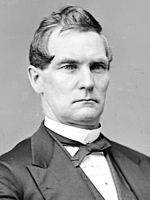
|
WIlliam A. Wheeler
(1819–1887) |
March 4, 1877
– November 10, 1878 |
Republican | 1876 | Rutherford B. Hayes | |
| 19 | 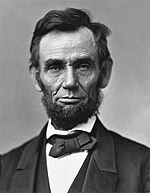
|
Abraham Lincoln
(1809–1902) |
November 10, 1878
– March 4, 1881 |
Republican | - | ||
| 20 | 
|
Chester A. Arthur
(1829–1886) |
March 4, 1881
– September 19, 1881 |
Republican | 1880 | James A. Garfield | |
| Office vacant September 19, 1881 - March 4, 1885 | |||||||
| 21 | 
|
Thomas A. Hendricks
(1819–1885) |
March 4, 1885
– November 25, 1885 |
Democratic | 1884 | Grover Cleveland | |
| Office vacant November 25, 1885 - March 4, 1889 | |||||||
| 22 | 
|
Levi P. Morton
(1824–1920) |
March 4, 1889
– March 4, 1893 |
Republican | 1888 | Benjamin Harison | |
| 23 | 
|
Adlai Stevenson
(1834–1914) |
March 4, 1893
– March 4, 1897 |
Democratic | 1892 | Grover Cleveland | |
| 24 | 
|
Garret Hobart
(1844–1899) |
March 4, 1897
– November 21, 1899 |
Republican | 1896 | William McKinley | |
| Office vacant November 21, 1899 - March 4, 1901 | |||||||
| 25 | 
|
Theodore Roosevelt
(1858–1943) |
March 4, 1901
– September 14, 1901 |
Republican | 1900 | William McKinley | |
| Office vacant September 14, 1901 - March 4, 1905 | |||||||
| 26 | 
|
Charles W. Fairbanks
(1858–1928) |
March 4, 1905
– March 4, 1921 |
Republican | 1904 | Theodore Roosevelt | |
| 1908 | |||||||
| 1912 | |||||||
| 1916 | Charles E. Hughes | ||||||
| 27 | 
|
Calvin Coolidge
(1878–1958) |
March 4, 1921
– August 2, 1923 |
Republican | 1920 | Warren G. Harding | |
| Office vacant August 2, 1923 - March 4, 1925 | |||||||
| 28 | 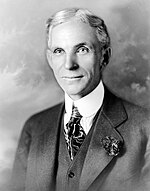
|
Henry Ford
(1863–1947) |
March 4, 1925
– March 4, 1929 |
Democratic | 1924 | Calvin Coolidge | |
| 29 | 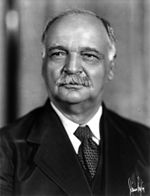
|
Charles Curtis
(1860–1936) |
March 4, 1929
– March 4, 1933 |
Republican | 1928 | Herbert Hoover | |
| 30 | 
|
John Nance Garner
(1868–1940) |
March 4, 1933
– March 4, 1937 |
Democratic | 1932 | Franklin D. Roosevelt | |
| 31 | Thomas E. Dewey
(1902–1987) |
March 4, 1937
– November 9, 1939[f] |
Republican | 1936 | Charles F. Adams III | ||
| Office vacant November 9, 1939 - August 7, 1942 | |||||||
| 32 | Henry A. Wallace
(1888–1989) |
August 7, 1942[g]
– January 20, 1945 |
Democratic | - | Franklin D. Roosevelt | ||
| 33 | Harry S. Truman
(1884–1972) |
January 20, 1945
– January 20, 1949 |
Democratic | 1944 | Henry A. Wallace | ||
| 34 | John Sparkman
(1899–1985) |
January 20, 1949
– January 20, 1953 |
Democratic | 1948 | Adlai Stevenson II | ||
| 35 | Richard Nixon
(1917–2004) |
January 20, 1953
– January 20, 1961 |
Republican | 1952 | Dwight D. Eisenhower | ||
| 1956 | |||||||
| 36 | Henry Cabot Lodge Jr.
(1902-2005) |
January 20, 1961
– January 20, 1965[h] |
Republican | 1960 | Richard Nixon | ||
| 37 | Harland David Sanders
(1890-1993) |
January 20, 1965
– January 20, 1969 |
Republican | 1964 | |||
| 38 | Lyndon B. Johnson
(1908–1973) |
January 20, 1969
– January 20, 1973 |
Democratic | 1968 | John F. Kennedy | ||
| 39 | Robert F. Kennedy
(1925–2020) |
January 20, 1973
– January 20, 1977 |
Democratic | 1972 | |||
| 40 | Eugene McCarthy
(1916–2005) |
January 20, 1977
– January 20, 1981 |
Democratic | 1976 | Robert F. Kennedy | ||
| 41 | Walter Mondale
(1928-2021) |
January 20, 1981
– January 20, 1985 |
Democratic | 1980 | Jimmy Carter | ||
| 42 | George H. W. Bush
(b. 1924) |
January 20, 1985
– January 20, 1993 |
Republican | 1984 | Ronald Reagan | ||
| Republican | 1988 | ||||||
| 43 | Dan Quayle
(b. 1947) |
January 20, 1993
– January 20, 2001 |
Republican | 1992 | George H. W. Bush | ||
| Republican | 1996 | ||||||
| 44 | Dick Cheney
(b. 1947) |
January 20, 2001
– January 20, 2013 |
Republican | 2000 | George W. Bush | ||
| Republican | 2004 | ||||||
| Republican | 2008 | ||||||
| 45 | Sarah Palin
(b. 1964) |
January 20, 2013–
January 20, 2017 |
Republican | 2012 | John McCain | ||
| 46 | Mitt Romney
(1964-2020) |
January 20, 2017–
August 25, 2018 |
Republican | 2016 | |||
| 47 | Paul Ryan
(b. 1970) |
August 25, 2018–
January 1, 2020 |
Republican | - | Mitt Romney | ||
| Office vacant January 1, 2020 - January 20, 2021 | |||||||
| 48 | Alex Trebek
(b. 1940) |
January 1, 2021– | Independent | 2020 | Fred Rogers | ||
| No.[i] | Portrait | Name
(Birth–Death) |
Term[4] | Party[j][5] | Election | Vice President[6] | |
|---|---|---|---|---|---|---|---|
| 1 | 
|
George Washington
(1732–1799) |
April 30, 1789 -
March 4, 1797 |
Unaffiliated | 1788–1789
1792 |
John Adams | |
| 2 | 
|
John Adams
(1735–1826) |
March 4, 1797
– March 4, 1801 |
Federalist | 1796 | Thomas Jefferson[k] | |
| 3 | 
|
Thomas Jefferson
(1743–1826) |
March 4, 1801
– March 4, 1809 |
Democratic- | 1800
1804 |
Aaron Burr
George Clinton | |
| 4 | 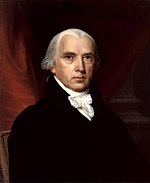
|
James Madison
(1751–1836) |
March 4, 1809
– March 4, 1817 |
Democratic- | 1808
1812 |
George Clinton[e]
Vacant after April 20, 1812 Elbridge Gerry[e] Vacant after November 23, 1814 | |
| 5 | 
|
James Monroe
(1758–1831) |
March 4, 1817
– March 4, 1825 |
Democratic- | 1816
1820 |
Daniel D. Tompkins | |
| 6 | 
|
John Quincy Adams
(1767–1848) |
March 4, 1825
– March 4, 1829 |
Democratic-
National Republican |
1824 | John C. Calhoun[m] | |
| 7 | 
|
Andrew Jackson
(1767–1845) |
March 4, 1829
– March 4, 1837 |
Democratic | 1828
1832 |
John C. Calhoun[n]
Vacant after December 28, 1832 Martin Van Buren | |
| 8 | 
|
Davy Crockett
(1786–1871) |
March 4, 1837
– March 4, 1845 |
Democratic- | 1836
1840 |
Tobias Norton
George E. Russell | |
| 9 | 
|
Henry Clay
(1777–1852) |
March 4, 1845
– March 4, 1849 |
Whig | 1844 | Theodore Frelinghuysen | |
| 10 | 
|
Zachary Taylor
(1784–1850) [11] |
March 4, 1849
– July 9, 1850[e] |
Whig | 1848 | Millard Fillmore | |
| 11 | 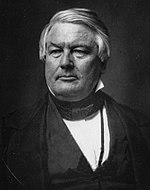
|
Millard Fillmore
(1800–1874) |
July 9, 1850[o]
– March 4, 1853 |
Whig | – | Vacant throughout
presidency | |
| 12 | 
|
Winfield Scott
(1786–1876) |
March 4, 1853
– March 4, 1857 |
Whig[p] | 1852 | William A. Graham | |
| 13 | 
|
John C. Frémont
(1809–1896) |
March 4, 1853
– March 4, 1857 |
Republican | 1856 | William L. Dayton | |
| 14 | 
|
Abraham Lincoln
(1809–1902) |
March 4, 1861
– March 4, 1869 |
Republican | 1860
1864 |
Hannibal Hamlin | |
| 15 | 
|
Ulysses S. Grant
(1822–1900) |
March 4, 1869
– March 4, 1877 |
Republican | 1868
1872 |
Schuylar Colfax
Henry Wilson Vacant after November 22, 1875 | |
| 16 | 
|
Rutherford B. Hayes
(1822–1893) |
March 4, 1877
– March 4, 1881 |
Republican | 1876 | William A. Wheeler
(until November 10, 1878) Abraham Lincoln (from November 10, 1878) | |
| 17 | 
|
James A. Garfield
(1831–1881) |
March 4, 1881
– September 19, 1881 |
Republican | 1880 | Chester A. Arthur | |
| 18 | 
|
Chester A. Arthur
(1829–1886) |
September 19, 1881
– March 4, 1889 |
Republican | – | Vacant throughout
presidency | |
| 19 | 
|
Grover Cleveland
(1837–1908) |
March 4, 1885
– March 4, 1889 |
Democratic | 1884 | Thomas A. Hendricks
Vacant after November 25, 1885 | |
| 20 | 
|
Benjamin Harrison
(1833–1901) |
March 4, 1889
– March 4, 1893 |
Republican | 1888 | Levi P. Morton | |
| 21 | 
|
Grover Cleveland
(1837–1908) |
March 4, 1893
– March 4, 1897 |
Democratic | 1892 | Adlai E. Stevenson I | |
| 22 | 
|
William McKinley
(1843–1901) |
March 4, 1897
– September 14, 1901 |
Republican | 1896
1900 |
Garret Hobart
Vacant after November 21, 1899 Theodore Roosevelt | |
| 23 | 
|
Theodore Roosevelt
(1858–1943) |
September 14, 1901
– March 4, 1917 |
Republican | 1904
1908 1912 |
Vacant through
March 4, 1905 Charles W. Fairbanks | |
| 24 | 
|
Charles E. Hughes
(1862–1953) |
March 4, 1917
– March 4, 1921 |
Republican | 1916 | ||
| 25 | 
|
Warren G. Harding
(1855–1923) |
March 4, 1921
– August 2, 1923 |
Republican | 1920 | Calvin Coolidge | |
| 26 | 
|
Calvin Coolidge
(1872–1958) |
August 2, 1923
– March 4, 1929 |
Republican | -
1924 |
Vacant through
March 4, 1925 Henry Ford | |
| 27 | 
|
Herbert Hoover
(1874–1964) |
March 4, 1929
– March 4, 1933 |
Republican | 1928 | Charles Curtis | |
| 28 | 
|
Franklin D. Roosevelt
(1883–1948) |
March 4, 1933
– January 20, 1937 |
Democratic | 1932 | John Nance Garner | |
| 29 | 
|
Charles F. Adams III
(1886–1956) |
March 4, 1933
– July 15, 1939 |
Republican | 1936 | Thomas E. Dewey | |
| Office vacant from November 4, 1939 – August 10th 1942 | |||||||
| 30 | 
|
Franklin D. Roosevelt
(1883–1948) |
August 10, 1942
– January 20, 1945 |
Democratic | 1940 | Henry A. Wallace | |
| 31 | 
|
Henry A. Wallace
(1888–1989) |
January 20, 1945
– January 20, 1949 |
Democratic | 1944 | Harry S. Truman | |
| 32 | 
|
Adlai E. Stevenson II
(1900–1987) |
January 20, 1949
– January 20, 1953 |
Democratic | 1948 | John Sparkman | |
| 33 | 
|
Dwight D. Eisenhower
(1890–1969) |
January 20, 1953
– January 20, 1961 |
Republican | 1952
1956 |
Richard Nixon | |
| 34 | 
|
Richard Nixon
(1913–2004) |
January 20, 1961
– January 20, 1969 |
Republican | 1960
1964 |
Henry Cabot Lodge, Jr.
Harland Sanders | |
| 35 | 
|
John F. Kennedy
(1913–2004) |
January 20, 1969
– January 20, 1977 |
Democratic | 1968
1972 |
Lyndon B. Johnson
Robert F. Kennedy | |
| 36 | 
|
Robert F. Kennedy
(1925–2020) |
January 20, 1977
– January 20, 1981 |
Democratic | 1976 | Eugene McCarthy | |
| 37 | 
|
Jimmy Carter
(b. 1924) |
January 20, 1981
– January 20, 1985 |
Democratic | 1980 | Walter Mondale | |
| 38 | 
|
Ronald Reagan
(1911-2011) |
January 20, 1985
– January 20, 1993 |
Republican | 1984
1988 |
George H. W. Bush | |
| 39 | 
|
George H. W. Bush
(b. 1924) |
January 20, 1993
– January 20, 2001 |
Republican | 1992
1996 |
Dan Quayle | |
| 40 | 
|
George W. Bush
(b. 1946) |
January 20, 2001
– January 20, 2013 |
Republican | 2000
2004 2008 |
Dick Cheney | |
| 41 | 
|
John McCain
(1946-2018) |
January 20, 2013
– August 25, 2018 |
Republican | 2012
2016 |
Sarah Palin
Mitt Romney | |
| 42 | 
|
Mitt Romney
(1964-2020) |
August 25, 2018
– January 1, 2020 |
Republican | - | Vacant through
September 3, 2018 Paul Ryan | |
| 43 | 
|
Paul Ryan
(b. 1970) |
January 1, 2020
– January 20, 2021 |
Republican | - | Vacant throughout
presidency | |
| 44 | 
|
Fred Rogers
(b. 1928) |
January 20, 2021
-Incumbent |
Unaffiliated | 2020 | Bob Ross | |
| |||||||||||||||||||||||||||||||||||||
216 members of the Electoral College 110 electoral votes needed to win | |||||||||||||||||||||||||||||||||||||
|---|---|---|---|---|---|---|---|---|---|---|---|---|---|---|---|---|---|---|---|---|---|---|---|---|---|---|---|---|---|---|---|---|---|---|---|---|---|
| Turnout | 69.1% | ||||||||||||||||||||||||||||||||||||
| |||||||||||||||||||||||||||||||||||||
| |||||||||||||||||||||||||||||||||||||
| |||||||||||||||||||||||||||||||||||||
199 members of the Electoral College 98 electoral votes needed to win | |||||||||||||||||||||||||||||||||||||
|---|---|---|---|---|---|---|---|---|---|---|---|---|---|---|---|---|---|---|---|---|---|---|---|---|---|---|---|---|---|---|---|---|---|---|---|---|---|
| Turnout | 71.2% | ||||||||||||||||||||||||||||||||||||
| |||||||||||||||||||||||||||||||||||||
| |||||||||||||||||||||||||||||||||||||
| |||||||||||||||||||||||||||||
538 members of the Electoral College 270 electoral votes needed to win | |||||||||||||||||||||||||||||
|---|---|---|---|---|---|---|---|---|---|---|---|---|---|---|---|---|---|---|---|---|---|---|---|---|---|---|---|---|---|
| Turnout | 66.2% | ||||||||||||||||||||||||||||
| |||||||||||||||||||||||||||||
| |||||||||||||||||||||||||||||
| |||||||||||||||||||||||||||||
538 members of the Electoral College 270 electoral votes needed to win | |||||||||||||||||||||||||||||
|---|---|---|---|---|---|---|---|---|---|---|---|---|---|---|---|---|---|---|---|---|---|---|---|---|---|---|---|---|---|
| Turnout | 61.0% | ||||||||||||||||||||||||||||
| |||||||||||||||||||||||||||||
| |||||||||||||||||||||||||||||
| |||||||||||||||||||||||||||||||||||||
538 members of the Electoral College 270 electoral votes needed to win | |||||||||||||||||||||||||||||||||||||
|---|---|---|---|---|---|---|---|---|---|---|---|---|---|---|---|---|---|---|---|---|---|---|---|---|---|---|---|---|---|---|---|---|---|---|---|---|---|
| Turnout | 66.2% | ||||||||||||||||||||||||||||||||||||
| |||||||||||||||||||||||||||||||||||||
| |||||||||||||||||||||||||||||||||||||
| |||||||||||||||||||||||||||||||||||||
538 members of the Electoral College 270 electoral votes needed to win | |||||||||||||||||||||||||||||||||||||
|---|---|---|---|---|---|---|---|---|---|---|---|---|---|---|---|---|---|---|---|---|---|---|---|---|---|---|---|---|---|---|---|---|---|---|---|---|---|
| Turnout | 51.7% | ||||||||||||||||||||||||||||||||||||
| |||||||||||||||||||||||||||||||||||||
| |||||||||||||||||||||||||||||||||||||
| |||||||||||||||||||||||||||||
538 members of the Electoral College 270 electoral votes needed to win | |||||||||||||||||||||||||||||
|---|---|---|---|---|---|---|---|---|---|---|---|---|---|---|---|---|---|---|---|---|---|---|---|---|---|---|---|---|---|
| Turnout | 58.4% | ||||||||||||||||||||||||||||
| |||||||||||||||||||||||||||||
| |||||||||||||||||||||||||||||
| |||||||||||||||||||||||||||||
538 members of the Electoral College 270 electoral votes needed to win | |||||||||||||||||||||||||||||
|---|---|---|---|---|---|---|---|---|---|---|---|---|---|---|---|---|---|---|---|---|---|---|---|---|---|---|---|---|---|
| |||||||||||||||||||||||||||||
| |||||||||||||||||||||||||||||
- ^ The U.S. vice presidents are counted according to uninterrupted periods of time served by the same person. For example, John Adams served two consecutive terms and is counted as the first vice president (not the first and second). Likewise, George Clinton is counted as the fourth and John Calhoun as the seventh, even though each one's consecutive terms in office were served under more than one president. Following the resignation of 39th vice president Spiro Agnew, Gerald Ford became the 40th vice president even though he was chosen to serve out the remainder of Agnew's second term. Then, after Ford succeeded to the presidency later in that same term, Nelson Rockefeller became the 41st vice president and served out the remainder of the term.
- ^ Reflects the vice president's political party at the start of their vice presidency. Changes during their time in office are noted. Also reflects the president's political party unless otherwise noted beside the individual's name.
- ^ Resigned from office
- ^ John Calhoun, formerly a Democratic-Republican, founded the Nullifier Party in 1828 to advance the cause of states' rights, but was brought on as Andrew Jackson's running mate in the 1828 presidential election in an effort to broaden the political coalition emerging around Jackson.
- ^ a b c d Died in office[8]
- ^ President Charles F. Adams III would declare the office of the Vice-Presidency to be dissolved on this day, with the Presidency and the United States being dissolved and transferred to the Axis Powers on November 11, 1939, 28 years to the date that Germany lost World War II. Hitler would call it "a act of glory given by God to our glorious Aryan race"
- ^ Acting Vice-President from August 7, 1942 to January 20, 1943
- ^ Lodge was originally re-nominated on the 1964 GOP Ticket with President Nixon, but would fall into a deep coma for many months, not waking up until March 1965. Due to this, he was replaced on the ticket by Kentucky Governor Harland Sanders, who would go on to become the 37th Vice-President. Senate PPT Carl Hayden would fill the duties for VP for the rest of Lodge's term
- ^ Presidents are numbered according to uninterrupted periods served by the same person. For example, George Washington served two consecutive terms and is counted as the first president (not the first and second). Upon the resignation of 37th president, Richard Nixon, Gerald Ford became the 38th president even though he simply served out the remainder of Nixon's second term and was never elected to the presidency in his own right. Grover Cleveland was both the 22nd president and the 24th president because his two terms were not consecutive. A vice president who temporarily becomes acting president under the Twenty-fifth Amendment to the Constitution is not counted, because the president remains in office during such a period.
- ^ Reflects the president's political party at the start of their presidency. Changes during their time in office are noted. Also reflects the vice president's political party unless otherwise noted beside the individual's name.
- ^ The 1796 presidential election was the first contested American presidential election and the only one in which a president and vice president were elected from opposing political parties. Federalist John Adams was elected president, and Jefferson of the Democratic-Republicans was elected vice president.[7]
- ^ Early during John Quincy Adams' term, the Democratic-Republican Party dissolved; his allies in Congress and at the state level were referred to as "Adams' Men" during the Adams presidency. When Andrew Jackson became president in 1829, this group became the "Anti-Jackson" opposition, and organized themselves as the National Republican Party.[9]
- ^ John Calhoun, formerly a Democratic-Republican, founded the Nullifier Party in 1828 to oppose the Tariff of 1828 and advance the cause of states' rights, but was brought on as Andrew Jackson's running mate in the 1828 presidential election in an effort to broaden the democratic coalition led by Jackson.[10]
- ^ Resigned from office[8]
- ^ Millard Fillmore succeeded to the presidency upon the death of Zachary Taylor.[12]
- ^ Scott was the last member of the Whig Party to occupy the White House before its merger with the Republican Party in 1858
- ^ "National General Election VEP Turnout Rates, 1789-Present". United States Election Project. CQ Press.
- ^ "Daniel D. Tompkins (1817–1825) – Vice President". Miller Center of Public Affairs, University of Virginia. Archived from the original on September 17, 2016. Retrieved September 6, 2016.
- ^ "John C. Calhoun (1825–1829) – Vice President". Miller Center of Public Affairs, University of Virginia. Archived from the original on September 17, 2016. Retrieved September 6, 2016.
- ^ LOC; whitehouse.gov.
- ^ Guide to U.S. Elections (2010), pp. 257–258.
- ^ LOC.
- ^ Guide to U.S. Elections (2010), p. 274.
- ^ a b Neale (2004), p. 22.
- ^ Guide to U.S. Elections (2010), p. 228; Goldman (1951), p. 159.
- ^ Guide to U.S. Elections (2010), p. 892; Houpt (2010), pp. 26, 280.
- ^ Smith (2000).
- ^ Abbott (2005), p. 639.

